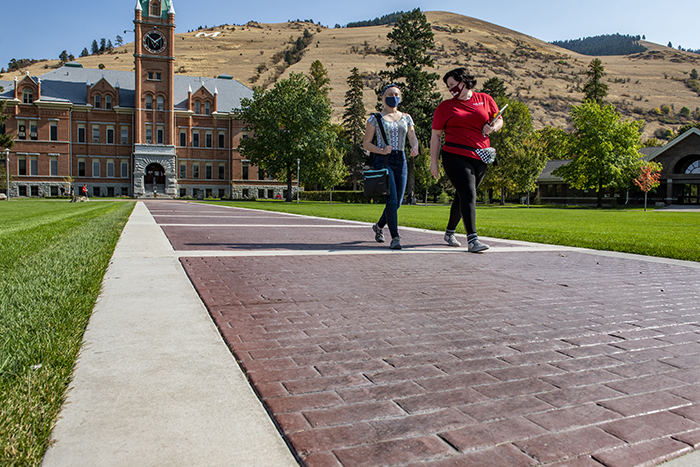- Editorial Offices
- 203 Brantly Hall
- Missoula, MT 59812
- (406) 243-2488
- themontanan@umontana.edu
Turning of the Stone
UM is paving a new future. One-hundred-year-old bricks, to be exact.UM is paving a new future, and the way forward includes the turning of some old stones. One-hundred-year-old bricks, to be exact.
This summer, the historic brick walkways of UM’s Oval got a facelift, thanks to a large-scale reconstruction project in the heart of campus. What used to be clunky and timeworn bricks that made riding bikes, rushing to class or wheelchair accessibility difficult, is now stamped, smooth concrete – leaving behind generations of stubbed toes and careful balancing on the iconic and beloved paths. “The problem was so many of them had become damaged from years of the freeze-thaw cycle,” says Kevin Krebsbach, director of UM Facility Services. “It caused most of them to settle and create hazards.”
“The problem was so many of them had become damaged from years of the freeze-thaw cycle,” says Kevin Krebsbach, director of UM Facility Services. “It caused most of them to settle and create hazards.”
Funds for the $250,000 infrastructure investment, awarded to Knife River of Missoula, were made available from a University bond sale last year that generated $63 million ear-marked for investments in student-serving infrastructure and capital improvements. The new concrete is textured to resemble bricks, reflecting UM’s classical aesthetic and original design.
The walkways didn’t exist at UM until 1969, when the bricks – originally laid in downtown Missoula streets between 1912 and 1914 – were removed and installed on campus as crossways that run east-west and north-south on the Oval. The first 80 years our campus lacked walkways across the Oval, and it was considered taboo to walk across the campus greens. University archives include records of a paddling punishment for those caught breaking the rules and a silent sentinel who blew a whistle when the greens were trespassed.
Krebsbach says most of the original brick workmanship was on-par for the times, despite some improper installation and flawed placement of the brick’s concrete borders which had worsened over time. The bricks came from the former Denny-Renton Clay & Coal Company in Renton, Washington – once the largest producers of brick pavers in the world.
Reflecting UM’s commitment to sustainability and bypassing the landfill as much as possible, Facilities Services wanted to recycle as many of the original bricks as possible that were still in usable condition.
Krebsbach said about 80% of the original bricks, estimated to be between 60,000 to 70,000, are still usable and currently sitting on pallets for future projects, or for a potential sale to the public – following many inquiries from alumni and the public about the project.
“What’s neat to me about the whole project is the restoring of the Oval’s grandeur and making something better that was already there,” Krebsbach says.
As Montana lays a new foundation for future generations, we honor our past as we start down a new path.




